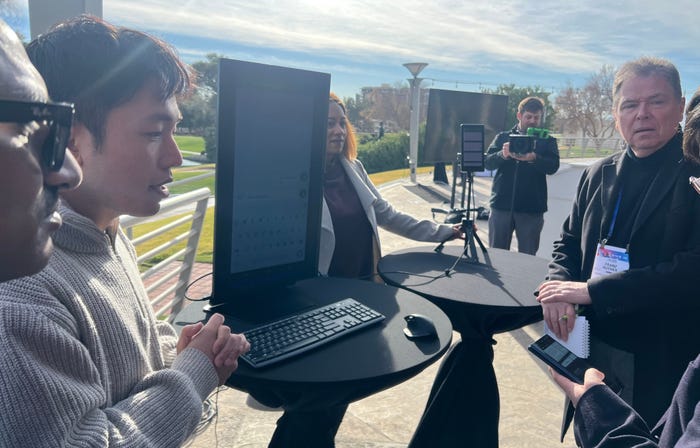Siyata to showcase new PTT device with body camera during IWCE 2023Siyata to showcase new PTT device with body camera during IWCE 2023

Siyata recently announced it will showcase its new SD7+ device—a handset form factor that integrates body-camera functionality with the company’s rugged SD7 dedicated push-to-talk-over-cellular device—during the upcoming IWCE 2023 event in Las Vegas.
Nick Yaeger, Siyata vice president of sales, said the SD7+ will be able to act as a body camera via Siyata’s partnership with Visual Labs, which allows users to manage the video from the camera. Users can access the push-to-talk (PTT) functionality while simultaneously using the body-camera feature via a speaker microphone, headset or pushing the talk button on the device, he said.
Having both the PTT and body-camera capabilities could allow the SD7+ to meet a niche in the marketplace.
“Not only can you now do a body cam from our device, but you can also do push to talk,” Yaeger said during an interview with IWCE’s Urgent Communications. “This is rare in the marketplace today, because most body cams are purpose-built body cameras.
“This gives an alternative to those traditional body cameras, … so you can have an all-in-one device. That allows you to not only see what’s going on but also to talk with people and tell them what’s going on.”
Yaeger said the body-camera capability of the SD7+ is an addition to the PTT functionality that users have been able to experience via Siyata’s SD7 device, which has gained attention in the industry as a cost-effective handset that is capable of supporting a variety of PTT technologies while using low-cost IoT data plans from carriers.
While the SD7+ plus also supports the same PTT functionality as the SD7 handset, any live streaming or even archiving of video from the SD7+ over a carrier network would require a more robust data plan than the IoT plans for PTT-only communications, according to Yaeger.
“It would need to be a bigger data plan,” he said. “We are working with the carriers to figure out which plan is correct for the use-case scenario.
“We’re hopeful that we can find a plan that meets all of the needs for everyone involved—for Visual Labs sending video back and forth, for the carriers, and for the customers—to keep the costs relatively low.”
Another difference for the SD7+ is the expected target audience. With the integrated body-camera functionality, “security and public safety are where we see the majority of the opportunity,” Yaeger said.
This would be a contrast to the PTT-focused SD7, which is proving to be attractive to enterprises and non-public-safety government agencies, he said.
“Every [SD7] customer says, ‘We want something simple and easy to use, easy to deploy and easy to manage, and this is the perfect device [to meet those criteria],” Yaeger said.
IWCE attendees will be able to view the SD7+ next week in Siyata’s booth #2125 on March 29-30. However, the new device is not yet available commercially, as it has not yet completed the certification process with laboratories for carriers like Verizon and AT&T.
Siyata has not announced a lauch date for the SD7+, but Yaeger said he is “really hoping” that the SD7+ could be an option for entities as they plan their budgets for the upcoming year.
Yaeger said that Siyata also has not yet determined the pricing for the SD7+ but said it would “for sure” be more cost effective than LMR solutions.
During IWCE, Siyata also will showcase its partnership—announced last fall—with CrisisGo, which leverages the SOS button on Siyata’s SD7 handset to send notifications to the proper personnel in the case of an emergency. A web interface also can support 2D or 3D mapping of a building associated with an incident, according to Siyata.
“[CrisisGo is] able to integrate into any iPhone or other device, but they haven’t had the ability to provide that instant communication through push-to-talk [services] very easily,” Yaeger said. “[CrisisGo] saw our [SD7] device as a perfect complement to their service.
“Now, they [users] can hit the panic button—they can hit the SOS button three times—to trigger a lockdown. [Officials with the entity] can now communicate over push-to-talk [service] what’s going on, such as whether there’s a need for a lockdown because there’s a fire, a flood, an active shooter or something else. They can have communication with that person who actually triggered the lockdown to find out what’s going on.”
Yaeger said a CrisisGo representative will be present in the Siyata booth during IWCE 2023.





